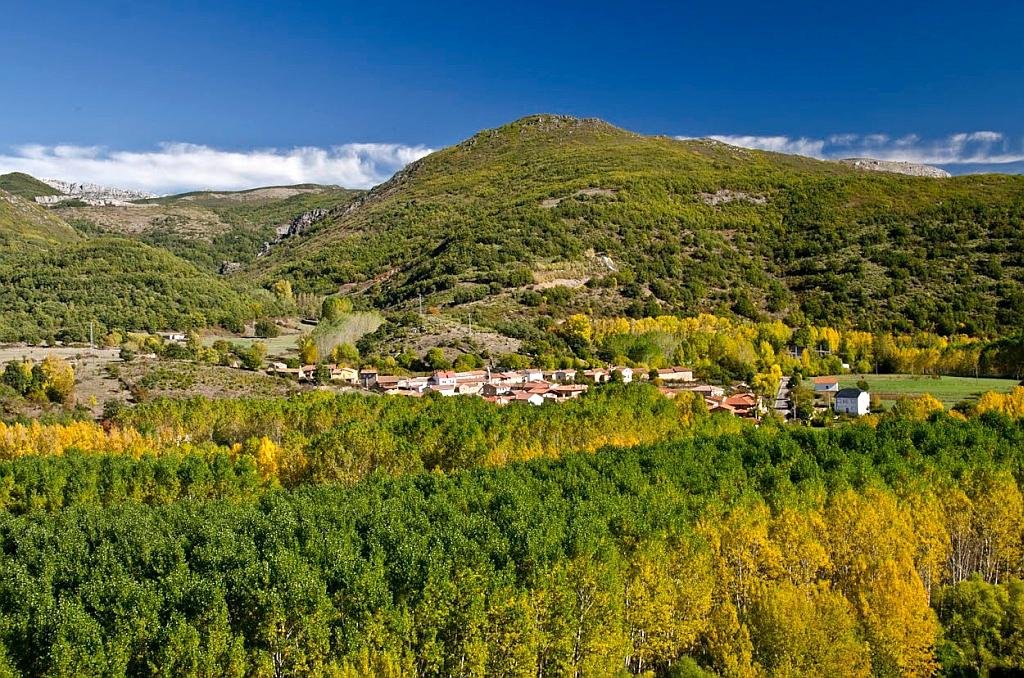- Region: Castilla y León (León)
- Declared a biosphere reserve: 2005
- Protected area: 81,000 hectares
- Main towns and villages: Los Barrios de Luna, Murias de Paredes, Riello, Sena de Luna, Soto y Amío, Valdesamario
Points of interest
Los Valles de Omaña y Luna biosphere reserve, at some point in the future, will join with the Alto Bernesga, Los Ancares Leoneses, Babia, Valled de Laciana, Los Argüellos and Picos de Europa to form the Castilla y León side of the “Great Cantabrian Biosphere Reserve”. This is a project in developement which hopes to turn the entire Cantabrian mountain chain into one enormous protected area. It aims to provide a permanent connection between the eastern and western populations of the Cantabrian brown bear and protection and conservation for many iconic Iberian wildlife species. There is also a deep emphasis on protecting and developing human culture and traditions of the area in harmony with the environment.
In the reserve area there are 86 towns and villages which have traditionally been dedicated to activities related to agriculture and livestock farming. During last century however, mining activities also provided employment and shaped the landscape that can be seen today.
In recent years there has been a decline in both coal mining and livestock farming coupled with a depopulation so the designation of this area as a biosphere reserve is expected to re-develop agriculture and livestock farming along with sustainable tourism.
Forming a part of the Cantabrian mountains this is a popular area for people interested in not only wildlife but also earth sciences such as geology and paleontology. Geological interest points, as well as the Global Geosite, in the valley of the Luna River are well worth the visit.
- The Trilobite Deposit and Paleozoic Series in Los Barrios de Luna.
- The Angular mismatch between Precambrian and Cambrian in Irede de Luna and Portilla de Luna.
- The Arcos de Agua and Peña Cefera Glacier-Periglacial Complex in Murias de Paredes.
- The Boeza Glacier Valley in Murias de Paredes and Igueña.
- The Limestone faults in Mallo de Luna.
- The River Capture and Glacio-Lacustrine Deposit in Puerto de La Magdalena.
- The Carboniferous Continental Deposit in Valdesmario.
Find a hotel close to the Los Valles de Omaña y Luna biosphere reserve
[booking_product_helper shortname=”los valles de omaña y luna biosphere reserve (leön)”]
Fauna and flora
The valleys of Omaña and Luna include numerous species of flora, many of them endemic. There are birch and Pyrenean oak forests also riverside woodlands of alder, willow and poplar that together with the traditional fields and pastures are arranged in mosaic with the high mountain landscapes.
The reserve is also inhabited by numerous species of fauna, some of which have their southern distribution limit in the region, such as the Cantabrian brown bear and the Capercaille. Other species of interest are the Iberian hare and endemic Iberian species such as the Pyrenean desman.
Hiking and walking.
There are some fantastic walking routes here that are well maintained and marked. They vary in difficulty: baja (low), media (medium) and alta (difficult) and are available on this website (in Spanish): https://omanayluna.com/que-hacer-rutas
Video (In Spanish) with some fantastic scenery
Infromation / visitor centres
Centro de interpretación Reserva de la Biosfera Valles de Omaña y Luna
Located in the “Casona”, the palace of the Counts of Luna (18th century), in the village of Murias de Paredes, This is the official interpretation centre for Los Valles de Omaña y Luna biosphere reserve. The centre has videos and exhibitions covering the natural history and cultural aspects of the area. In order to visit it is recommended to email the office first (turismoaytomuriasdeparedes@gmail.com or tecnicos@omanayluna.com)
Museo del pastor (Barrios de Luna)
This is a museum in the village of Barrios de Luna dedicated to rural life and livestock farming. There are fascinating collections showing what life was like in the past for those working with animals in the area.
Centro de interpretación: “La explosión de vida en el cámbrico” (Miñera de Luna)
The Barrios de Luna constitute an enclave of geological interest at an international level. Since the 1950s, geologists and paleontologists from all over the world have come to Luna to study the valuable information stored in its rocks, which has allowed us to know different aspects of the evolution of the planet and the Cantabrian mountain range.
There are panels and showcases in which various aspects of the local geology are explained, with special attention to the explosion of life that occurred in the Cambrian. This centre in the village of Miñera de Luna also holds a remarkable collection of fossils.
Colección etnográfica (Sena de Luna)
Located in the old blacksmiths forge in the village of Sena de Luna this is an impressive collection of photographs donated by the local people giving an insight into the cultural past of the population living here generation after generation.
The official website for the Los Valles de Omaña y Luna biosphere reserve: https://omanayluna.com/
Iberia Nature Forum
Discover the Iberia Nature Forum – Environment, geography, nature, landscape, climate, culture, history, rural tourism and travel.
Iberia Nature Forum: https://iberianatureforum.com/
I’ve been living in this lovely area of Western Andalucia for the last 20 years or so and dedicate most of my time to the running of English language tourist information websites for the towns of Cádiz, Ronda, Grazalema, the famous or infamous Caminito del Rey, and also Wildside Holidays, which promotes sustainable and eco-friendly businesses running wildlife and walking holidays in Spain. My articles contain affiliate links that will help you reserve a hotel, bus, train or activity in the area. You don’t pay more, but by using them you do support this website. Thankyou!
